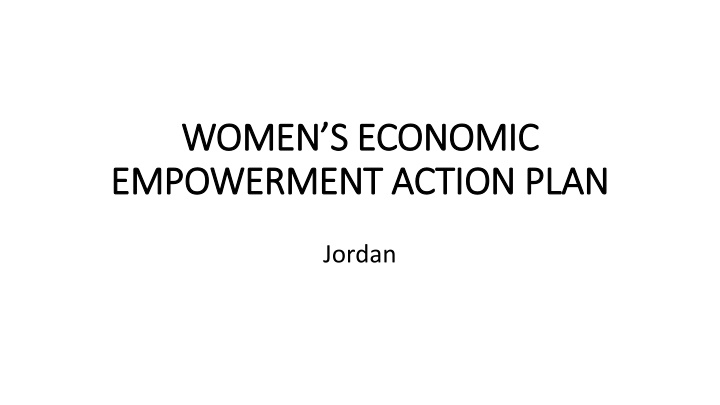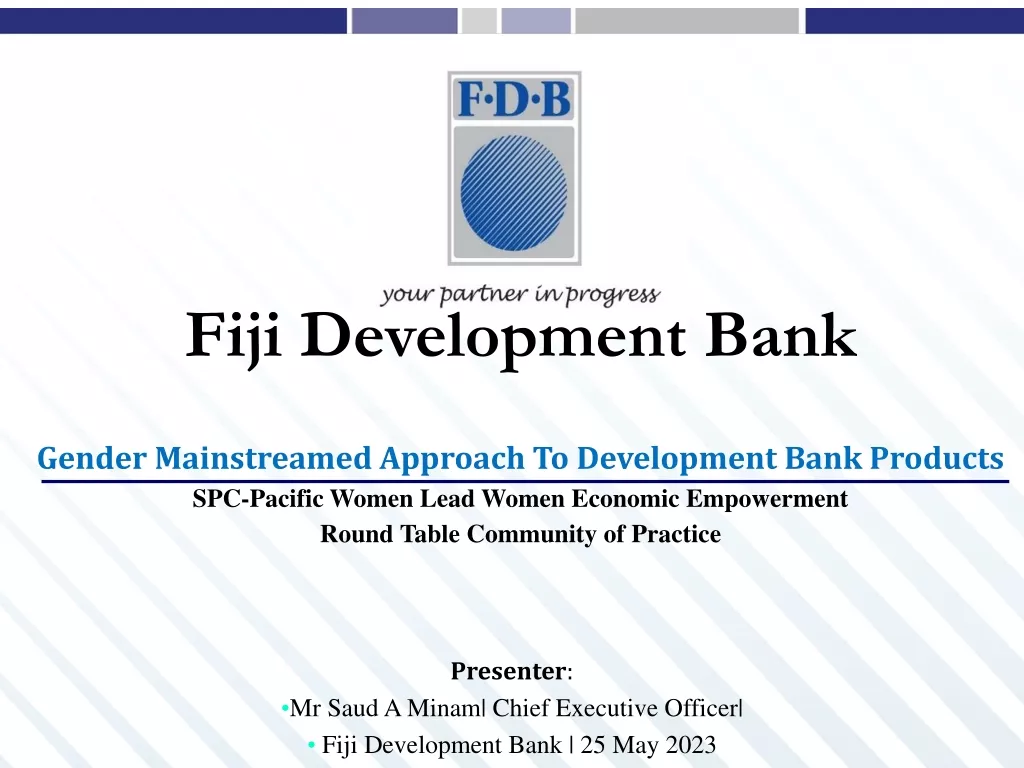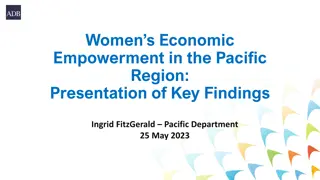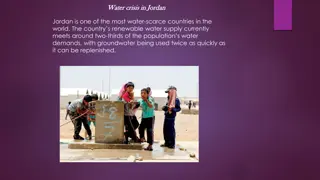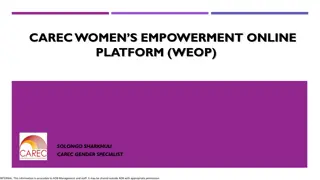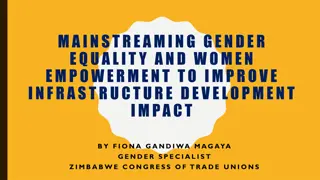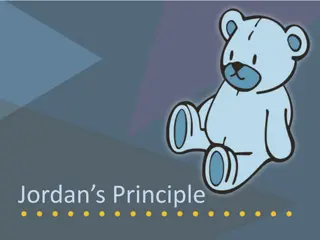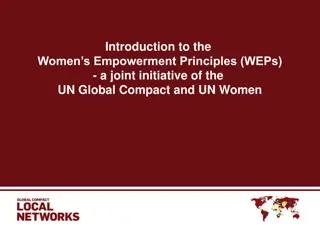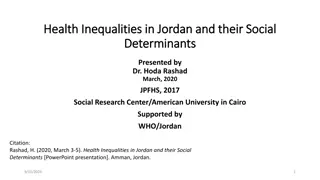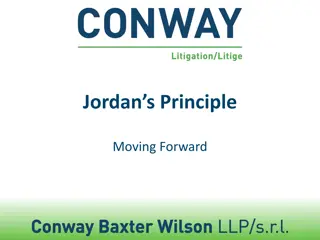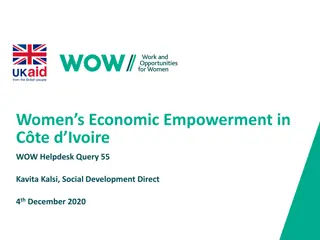Challenges and Opportunities for Women's Economic Empowerment in Jordan
Jordan faces various challenges in promoting women's economic opportunities, including a gender pay gap, low female participation rates, and limited access to finance and assets. Social norms, labor legislation, and biases also hinder women's entry and growth in the workforce. Despite these obstacles, efforts are being made to enhance women's economic empowerment in Jordan through addressing key persistent challenges.
Download Presentation

Please find below an Image/Link to download the presentation.
The content on the website is provided AS IS for your information and personal use only. It may not be sold, licensed, or shared on other websites without obtaining consent from the author.If you encounter any issues during the download, it is possible that the publisher has removed the file from their server.
You are allowed to download the files provided on this website for personal or commercial use, subject to the condition that they are used lawfully. All files are the property of their respective owners.
The content on the website is provided AS IS for your information and personal use only. It may not be sold, licensed, or shared on other websites without obtaining consent from the author.
E N D
Presentation Transcript
WOMENS ECONOMIC WOMEN S ECONOMIC EMPOWERMENT ACTION PLAN EMPOWERMENT ACTION PLAN Jordan
Jordan Our commitments to enhancing Our commitments to enhancing women s economic opportunities women s economic opportunities
Jordan: What the data tells us on womens economic opportunities women Men Working Jordanian women are concentrated in social fields including public administration, education, and human health and social work. (DOS, 2017) Own account worker/employer 4.7% 17.3% 15.8% Gender Pay Gap stands at 13.8% in the public sector and 15.5% in the private sector.(DOS, 2016) Unemployment rate 27.2% 16.9% Economic participation 62.7% 0% 20% 40% 60% 80% Education 40.6% Other sectors 32.1% Women economic participation in Jordan stands at 16.9% compared to men 62.7%. (DOS, 2017) Women unemployment rate stands at 27.2% compared to 15.8% among men (DOS, 2017). High employment rate among educated women: 33.9% among university graduates and 32.1% among intermediate diploma holders (DOS, 2017). Only 4.7% of employed Jordanian women are employers or own account workers compared with 17.3% of employed Jordanian men (DOS, 2017). Health and social work 14.5% Public administration 12.8%
Jordan: What the data tells us on womens economic opportunities women Men Jordan s gender equality indicators are consistently low on economic opportunity. The Global Gender Gap Report 2018 places Jordan at 138/149. Jordan ranks 45/149 in educational attainment, empowerment and 144/149 in economic participation and opportunity (WEF, Global Gender Gap Report, 2018). 3.3% ETA 129/149 in political 12.8% Women as business owners: firms with female co owners (19%), firms with female top managers (2%) (WEF, Global Gender Gap Report, 2018). 0% 5% 10% 15% Jordan has one of the lowest levels of female participation in total early-stage entrepreneurial activity (TEA) (TEA 3.3% for females, 12.8% for males (Global Entrepreneurship Monitor, 2017). Women in business 2.0% Firms with females in top management 19.0% Firms with female co-owners 0% 5% 10% 15% 20%
Jordan: Key, persistent challenges to increased opportunities for women in the economic realm Labor legislations include gender-based differences contributing to gender segmentation in the labor market. The same legislations also lack sufficient measures to ensure that women have equal opportunities in accessing the labor market and remaining in the labor force. Examples: Sector and hourly restrictions on employment of women, Lack of code of conduct on harassment in workplace, Lack of equal- remuneration requirements. Insufficient provision of supporting services, mainly affordable childcare. Women s mobility is still constrained by lack of safe and affordable public transport. Social expectations and norms are still affecting women s economic participation and are contributing to gender segmentation in the labor force. Hiring and employment biases, especially from the employers perspectives, are reducing the chances of women to enter the labor market, in addition to their chances of job growth and promotion. Low wages and pay gap are further discouraging women from entering the labor market and staying employed. Access to assets and finance are limiting entrepreneurship among women and reducing the growth opportunities of women-owned businesses.
Jordan: What we are doing Amending the labor Law and relevant legislations to promote women s economic participation by removing sectoral and hourly restrictions to women s employment, expanding the implementation of flexible work and protecting wages through digital payments. Enhancing the capacity of the GoJ to identify and address constrains to women economic participation, supported by knowledge and evidence by building the capacity of the GoJ to expand the availability of gender- sensitive statistics, gender-responsive budgeting and to expand knowledge on gender gaps and women economic empowerment. Support the creation of family-friendly and non-discriminatory work environment by expanding the provision of childcare through streamlines licensing, expanded modalities and incentives, in addition to provision of reliable and safe public transportation. Enhancing the employment of women in the private sector by supporting the creation of decent jobs for women in multiple sectors including manufacturing and the care economy, and strengthening women s leadership roles in unions and professional associations. Increasing the number of female-led MSMEs and cooperatives and supporting their growth by connecting women enterprises to global value chains, expanding their access to financial products and services, and supporting women cooperative and associations. Improving attitudes towards women s work among employers and the community at large through advocacy and improvement of education curricula.
Jordan: In five years from now, this is where we want to be Contributing to achieve the target of Jordan vision 2025 to increase women economic participation to 24% by 2025. More women are active in the labor market, and working women remain active in a family-friendly and discrimination-free work environment. More women have access to economic opportunities as business owners. Consequently, increasing economic activity among women in Jordan.
Jordan: This is how well do it Increased economic activity among women in the Mashreq region 1.An enabling environment with increased capacity for stakeholders to address constraints for women s economic participation strengthened 2. Women s access to economic opportunities improved 1.1 Legislation, procedures, practices revised, and constraints to women s economic empowerment removed while observing GoJ s international commitments 1.2 Capacity of Government agencies to identify and address constraints to women s economic empowerment enhanced, Knowledge & evidence regarding solutions to women s economic opportunities increased 1.3 Family-friendly and discrimination free work environment created and sustained 1.4 Attitudes towards women s work among employers and the community at large changed 2.1 Female employment in private sector increased 2.2 Female-led MSMEs and cooperatives increased
Jordan: This is how well do it 1.1 Legislation, procedures, practices revised, and constraints to women s economic empowerment removed while observing GoJ s international commitments. 1.2 Capacity of Government agencies to identify and address constraints to women s economic empowerment enhanced, Knowledge & evidence regarding solutions to women s economic opportunities increased. 1.1.1Amend labor legislation to be more gender sensitive and inclusive (revise the working hours of women, sector segmentation; establish and enforce guidelines to prevent violence and harassment in the world of work, and child care). 1.1.2Social security coverage expanded to all workers. 1.1.3Expand implementation of flexible work arrangements with decent work conditions. (Expand legal framework, clarify implementation arrangement, develop and provide incentives, amend labor law and social security compliance, using technology as an enabling tool for women empowerment). 1.1.4Wage protection including digital payment for all sectors. 1.1.5Expand legal protection to employees that demand labor rights. 1.1.1Build capacity of Department of Statistics and encourage and enforce gender-sensitive statistics. 1.1.2Build capacity of GoJ to expand Gender Responsive Budgeting. 1.1.3Develop a gender mainstreaming policy for GoJ and encourage the establishment of a gender audit unit. 1.1.4Build capacity of national and local executive bodies to deliver gender-sensitive public services and infrastructure. 1.1.5Sex disaggregated data is improved and available for relevant stakeholders (including DOS and government administrative records). 1.1.6Improve knowledge on gender gaps through research (including unpaid care work (time-use survey), wages gap in health sector, gender gap related to access to information and technology, gender gap in access to asset ownership). 1.1.7Improve knowledge on effectiveness of programs on women economic empowerment through research (including impact of microfinance on women economic empowerment).
Jordan: This is how well do it 1.3 Family-friendly and discrimination -free work environment created and sustained. 1.4 Attitudes towards women s work among employers and the community at large changed. 1.3.1Adequate and affordable childcare services expanded (modifying and enforcing legal framework, expanding implementation modalities, streamlining licensing process (one stop shop), and configuration of fiscal incentives). 1.3.2Gender inclusive solutions for reliable, accessible, safe, and affordable public transportation is found, and endorsed. 1.3.3Code of ethics for drivers and workers in public transportation endorsed by the Land Transport Regulatory Commission. 1.4.1Behavioral and social norms improved (advocacy campaigns, involvement of men and boys). 1.4.2Improve education curricula to promote gender equality and women s empowerment in formal non-formal education.
Jordan: This is how well do it 2.1 Female employment in private sector increased 2.2 Female-led MSMEs and cooperatives increased 2.2.1Connect women MSME to local and global supply and market chains through technical assistance. 2.2.2Support women-owned business through capacity building and technical assistance (to respond to procurement calls training courses/skills development on competitive bidding, procurement processes, financial management, using ICT to grow their businesses and in ICT, business registration). 2.2.3Develop, promote and implement other forms of learning for women-led MSME (mentorship, non- cognitive training). 2.2.4Business women s organizations are empowered to participate in debates and decision-making processes about public investments (e.g. training and capacity building for women s organizations). 2.2.5Identify and promote business opportunities in the care economy, including formalization/creation of childcare facilities, elderly care and care for persons with disabilities (address unpaid care and vouchers mechanism). 2.2.6Support for existing and newly established cooperatives to run their business (business plans development, technical support, managerial support etc.). 2.2.7Home-based businesses scaled up and promoted according to new regulations (reduce fees outside Amman, facilitate and streamline registration process). 2.2.8Expand gender-responsive lending solutions and investments (though engagement with development banks, commercial banks, private investors and associations) 2.1.1Technical and financial support provided to satellite factories to employ more women beyond the garment sector to enhance decent work and productivity. 2.1.2Identify, promote and create decent work (rights at work, benefits and social protections, living wage, and promote formalization employment) opportunities in all sectors. 2.1.3Capacity development of women s associations to engage and advocate for gender-responsive lending products and services developed. 2.1.4Strengthening leadership positions of women in trade unions and professional association, and boards of company. 2.1.5 Fiscal and tax incentives for companies that employ a certain percentage of women (proposed 30%).
Jordan: The broader commitment going forward Jordan Gender Action Plan will be implemented through broader commitments of multiple stakeholders including key government partners: MOPIC. (Ministry of Planning & International Cooperation) MOL. (Ministry of Labor) MOSD. (Ministry of Social Development) MOIAT. (Ministry of Industry & Trade). DOS. (Department of Statistics). SSC. (Social Security Corporation). JNCW (Jordan National Commission for Women). Other partners: International organizations including ILO, UNWOMEN and the World Bank The private sector through employers organizations including Chambers and business associations Association and non governmental organization (civil society).
Jordan: Potential risks and how we will deal with them Risks Proposed mitigation measures Limited economic growth in the past years may persist resulting in weak labor demand. Regularly review labor supply and demand statistics, and consequently expand and align a interventions with sectors that indicate potential growth. Political instability in the region, especially in countries with strong trade ties to Jordan, could affect Jordan s markets and consequently job creation. Align interventions with sectors exporting to more stable markets. Coordinate closely with GoJ efforts and strategies to expand exports to ensure gender integration Limited human resources to implement the required policy changes. Prioritize capacity development activities during implementation and expand learning exercises through knowledge sharing. Social norms and conservative views on women economic participation may still reduce the willingness of women to participate in the labor market. Implement activities addressing social norms across all interventions. Ensure the involvement of men and boys in all activities addressing the limitations on women economic empowerment resulting from social norms.
